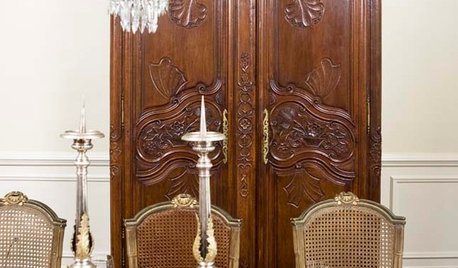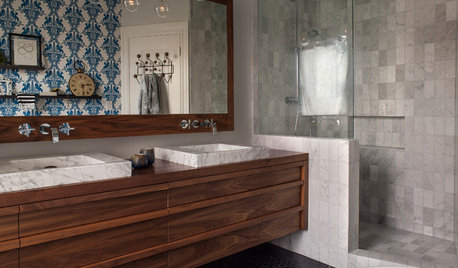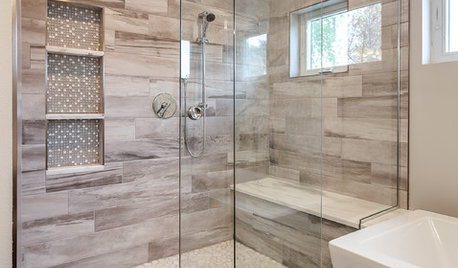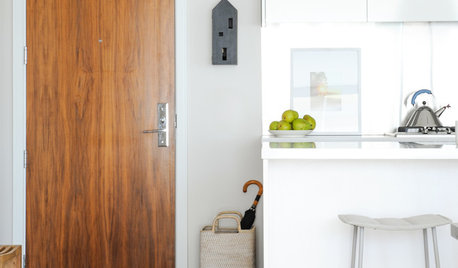Linseed oil before painting ancient siding?
AMRadiohead3885
17 years ago
Featured Answer
Sort by:Oldest
Comments (11)
sombreuil_mongrel
17 years agobrickeyee
17 years agoRelated Discussions
Painting vs vinyl siding
Comments (9)Abbey, I think those little screened thingies are vents, not for the paint, but for the walls. What kind of, if any, insulation do you have in the walls? It's possible they are the covers from a blown-in insulation job. Houses that are lived in throw off a surprising amount of moisture through water vapor generated by cooking, plants, breathing, showers, laundry etc. Good exhaust vans, used faithfully, can help this. Before the modern area (and your house falls in the before group, the same as my 160 y.o. house does) there wasn't much effort to really seal up, or even insulate houses. Then along came the oil shocks in the 70's and people started sealing up and insulating for all they were worth. The problem was however, they were insulating (and conscientiously sealing up drafts) so much that they were interfering with the structures' innate vapor handling capacity. Post 1970's houses that are built from scratch have something called a vapor barrier just under whatever wall surface there is (wallboard, plaster, etc.) It's purpose is to contain internally generated moisture and keep it from migrating through the wall surface and either creating problems within the wall insulation or carrying on out and causing the paint to fail from the outside in. And paradoxically (you're not going to want to hear this) insulating an attic where the insulation covers over the tops of the walls can aggravate the moisture retention problems by blocking subtle airflow up through the walls, and on out of the building. I wouldn't suggest un-insulating, just step up efforts to get the moisture out in other ways. To sort out what's going on, I would study the exterior walls, and maybe make a diagram of where the peeling is the worst. Is it by any chance just outside of on the wall above the kitchen, laundry or bathroom? If so and if you don't have exhaust fans that would suggest o me that you have a moisture migration problem. The cure for that is obviously fans that are used conscientiously to immediately remove moisture. This makes a big difference. Another possible solution is vapor retardant wall paint either under a finish coat, or as a finish coat. (Or you could tear out your interior walls and attempt to retrofit a VB ..... don't worry I wouldn't do that either, but it's something to think about if you ever are going that far in for another reason.) OTOH, perhaps it's peeling simply from exposure and being overpainted and not atended to. Southern aand western exposures often fail first in the NE because of the strong sunlight. Eastern exposures seem to last longer. This may not be the same where you are, but you can get the idea by studying other houses nearby and seeing how they compare with yours. One final note: Do you really have wod siding? I owned a 60's ranch once and its siding was some sort of pressboard/composite. It wouldn't be worth going to a lot of trouble to retain. Though I wouldn't go with vinyl, I;d reside with new wood, properly installed and backprimed. And don't let people tell you that your wood siding doesn't matter because it doesn't have a lot of trim flourishes. The fine detail of it, and it's long lifespan - I wouldn't expect vinyl to last as long as your wood already has - make it worth conserving, if you can. Even if it's in need of paint and a thorough overhaul, since it's wood, that possibility is there; with vinyl I;m not sure what you do, other than ri[p it off and reinstall. There's another fine touch that you house may have, that you may not even have noticed. Many wood-sided houses actually have a varying width on the clapboards, with lower ones being slightly closer together (i.e. with more overlap) than the upper ones. This is not an accident, but an old fashioned way to put more wood down low where eaves would drip. The visual effect is very subtle, but pleasing to the eye; I think it adds to the visual solidity of the overall look of the house. And it's the level of detail you would be giving up if you just slap on pre-formed vinyl. I'm attaching a link to the Index of the Presevation Bulletin Series. Please don't be daunted that your house isn't old, yet. With good, loving care, it will be someday. I have found the info in these bulletins excellent jumping off points. Hope they are equally helpful to you. While I suppose there is a conversion factor for house years v human years, similar to human years v dog years, it warmed my heart to hear a house "born" in 1950 as not particularly old. I was born that year too, so I guess I shouldn't worry about feeling old! HTH Molly~ Here is a link that might be useful: Link to National Parks Series of Preservation Bulletins; Topics include vinyl siding, painting exteriors and moisture control...See Morehow to prep asbestos siding for painting?
Comments (7)Katherine, can you show me some data showing the vinegar is a fungicide or retards growth of fungus (mold)? From what i've seen, to kill tested species, straight or nearly straight vinegar (5% acetic acid off the shelf). I suppose it might be cost effective to wash a few thousand square feet of siding and roofing at $2.50/gallon if it is effective. Maybe it is less expensive to buy it by the drum. How about the quantitative contribution of washing siding with TSP on phosphates in some watershed? Do you have any information about that? If the phosphate is a problem, you can certainly use the carbonate salt instead, but it won't work as well. You plants may well use up the phosphate before it can get into the ground water or surface run-off. Even before removal of phosphate from routine household cleaning agents, I wonder what its contribution to the watershed problems was compared to fertilizer use. Sodium hypochlorite (bleach) is not running anywhere. It reacts immediately with organic material in the soil. Think about the effectiveness of bleach as a disinfectant on dirty surfaces (compared to clean surfaces as directed). It is not great, requiring use of a lot more because it gets inactivated by the soil on the material you want to disinfect.) Basically it is gone as soon as it hits quantitatively significant organic material I've seen essential oils listed as effective pesticides, but I have not found any listings for fungicidal, algicidal or bactericidal use. Can you point me to some results from a recognized, authoritative testing agency. I have looked for damage on plants splashed with activated (alkalinized) sodium hypochlorite solutions. I've never found any. I think it is an urban legend, but maybe I will intentionally try to damage some foliage to see what it takes. Will you join in that endeavor? I suggest some range of bleach dilutions starting with "disinfectant bleach" since that has concentration certified as sufficient. Other variables might include a wetting of the plants before exposure and washing post exposure....See MoreAllback Linseed Oil
Comments (5)Interesting there Charlie! I'm suspecting (emphasize "suspecting"!) that your good luck with your paintjobs stems mostly from the wood itself. 150yo cedar wood be an ideal wood for an oil primer. * The older-growth cedars just aren't all that common any more. * Probably was a very slow-growth type also...meaning dense, stable wood, cut from bigger trees. * Many of todays Cedars just don't compare. Trees are harvested quicker, and the wood is softer. >>> This might sound corny, but in a sense, you have "Stradivarius" wood! The wood/old varnishes used in these priceless instruments simply can't be replicated anymore, largely because of the wood itself. Very dense, old hardwoods just aren't there...too bad! I've History-Channel type documentaries & other info. on this debate too...interesting stuff! I'll have to look into Allsback more, but because they have to refine it so much.... For now, I'd put more faith into your wood, & the Oil primer itself! I'd also consider doing 2 coats of primer, instead of Linseed as one of these coats. Faron...See MorePainting exterior of house with cedar siding---what to expect
Comments (2)One of the great virtues of cedar siding is that it does not need to be painted to look good for many, many years. Before you commit to a paint job, see if a painting contractor will clean and perhaps use a clear penetrating oil on your siding. Cedar, whether it's in the form of shakes or clapboards, does not tend to hold paint very well. The same chemicals within the cedar that make it so rot resistant make paint adhesion more difficult. Any knots also tend to bleed through even careful paint jobs pretty quickly....See Moreericwi
17 years agohousekeeping
17 years agocorgilvr
17 years agosombreuil_mongrel
17 years agohousekeeping
17 years agocorgilvr
17 years agojohn_shearerpainting_com
13 years agomacv
13 years ago
Related Stories

HOUZZ TOURSMy Houzz: When Memories of Home Are of Paint and Linseed Oil
A San Francisco Bay Area artist’s sun-drenched home doubles as her gallery and studio
Full Story
ECLECTIC HOMESHouzz Tour: Ancient and New Tell a Story in San Francisco
Chinese artifacts join 1970s art and much more in a highly personal, lovingly reincarnated 1896 home
Full Story
FURNITUREArmoires Travel From Ancient Rome to High-Style Storage
Go ahead, be possessive — this beautiful furniture piece with a rich history gives your treasures a proper home
Full Story
GREAT HOME PROJECTSWhat to Know Before Refinishing Your Floors
Learn costs and other important details about renewing a hardwood floor — and the one mistake you should avoid
Full Story
MATERIALSWhat to Ask Before Choosing a Hardwood Floor
We give you the details on cost, installation, wood varieties and more to help you pick the right hardwood flooring
Full Story
DOORS5 Questions to Ask Before Installing a Barn Door
Find out whether that barn door you love is the right solution for your space
Full Story
BEFORE AND AFTERSBefore and After: 19 Dramatic Bathroom Makeovers
See what's possible with these examples of bathroom remodels that wow
Full Story
REMODELING GUIDESWhat to Know Before You Tear Down That Wall
Great Home Projects: Opening up a room? Learn who to hire, what it’ll cost and how long it will take
Full Story
BATHROOM DESIGN10 Things to Consider Before Remodeling Your Bathroom
A designer shares her tips for your bathroom renovation
Full Story
MOST POPULAR5 Ways to Pare Down Your Stuff — Before It Gets in the Door
Want to free up some room around the house? Rethink gift giving, give yourself a shopping mantra and just say, ‘No, thank you’ to freebies
Full Story







HU-709615851